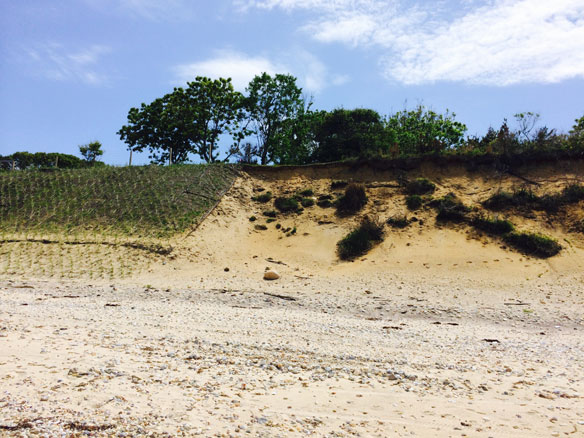
Coastal restoration, New York. Photograph: © SAF — Coastal Care
By NOAA;
The resilience of U.S. coastal communities to storms, flooding, erosion and other threats can be strengthened when they are protected by natural infrastructure such as marshes, reefs, and beaches, or with hybrid approaches, such as a “living shoreline” — a combination of natural habitat and built infrastructure, according to a new NOAA study.
The study, published in Environmental Science and Policy, assesses reports and peer-reviewed studies on the strengths and weaknesses of using built infrastructure, such as seawalls or dikes, natural infrastructure, or approaches which combine both. The study focuses on how these approaches help coastal communities reduce their risk of flooding and erosion, as well as additional benefits, and the tradeoffs when decision makers choose one type over another.
“When making coastal protection decisions, it’s important to recognize that built infrastructure only provides benefits when storms are approaching, but natural and hybrid systems provide additional benefits, including opportunities for fishing and recreation, all the time,” said Ariana Sutton-Grier, Ph.D., the study’s lead author, member of the research faculty at University of Maryland and NOAA’s National Ocean Service ecosystem science adviser. “Natural and hybrid systems can also improve water quality, provide habitat for many important species, and mitigate carbon going into our atmosphere.”
Threats like coastal erosion, storms and flooding can reshape the shoreline and threaten coastal property. With approximately 350,000 houses, business, bridges and other structures located within 500 feet of the nation’s shoreline, erosion is a problem many U.S. coastal communities are addressing.
Coastal flooding caused by extreme weather events and sea level rise is of growing global concern. As noted in this study, in 2012 there were 11 weather and climate billion-dollar disaster events across the United States, including superstorm Sandy, causing 377 deaths and more than $110 billion in damages. While only two of those were coastal events, Sandy alone was responsible for nearly sixty percent of the damages, at $65 billion (the other, Hurricane Isaac, caused $3 billion in damage). Nationally, these made 2012 the second costliest year on record for weather disasters. Only 2005, which incurred $160 billion in damages due in part to four devastating coastal hurricanes, saw more.
“Coastal resiliency and disaster risk reduction have become a national priority, and healthy coastal ecosystems play an important role in building resilient communities,” said Holly Bamford, Ph.D., acting assistant secretary of commerce for conservation and management at NOAA, and co-author of the study. “We know that sea levels are rising and that coastal communities are becoming more vulnerable to extreme weather- and climate-related events. Now is the time to invest in protection to secure our coasts, but we need to make those investments wisely and with a full understanding of the costs and benefits of different approaches.”
The study points out that there is still a need for built approaches in some locations. However, natural or hybrid approaches can be used in many cases.
Some natural ecosystems can maintain themselves, recovering after storm events and reducing the cost of upkeep. Natural habitats such as coral reefs, marshes and dunes can act as buffers for waves, storms and floods. Natural ecosystems also can, in many cases, keep pace with sea level rise, while built infrastructure does not adapt to changing conditions.
“There is a lot of potential innovation with hybrid approaches,” said Katya Wowk, Ph.D., NOAA senior social scientist, and the third co-author of the study. “Hybrid approaches, using both built and natural infrastructure, often provide more cost-effective flood risk reduction options and alternatives for communities when there is not enough space to use natural coastal protection alone.”
Hybrid approaches, such as combining some habitat restoration with openable flood gates or removable flood walls, provide benefits while also providing more storm and erosion protection than natural approaches alone. The study highlights hybrid approaches in the New York City metro area and in Seoul, South Korea, to deal with their monsoon flooding events.
“One of the challenging aspects is that these approaches are very new, so we are still learning what works best in which situations and under what circumstances,” said Wowk.
The authors suggest that every location where hybrid and natural approaches are being implemented provide opportunities for monitoring so we can learn as much as possible about each approach, including longer-term cost effectiveness.
“There is no ‘one size fits all’ solution when it comes to what is best for a community in providing coastal protection from flooding,” said Bamford. “We all have to work to innovate, test, monitor, and develop a better suite of options that includes more natural and hybrid infrastructure alternatives for providing coastal protection to communities around the world.”
“Seawalls Kill Beaches,” Open Letters by Warner Chabot And Rob Young, (10-03-2014)

Coral reefs protect shorelines from currents, waves, and storms. Healthy reefs have rough surfaces and complex structures that slow incoming waves — dissipating much of the force. Captions: NOAA. Photograph: © SAF — Coastal Care









